Among those who come to Africa to join a safari, the holy grail of animal tracking is the so called ‘Big Five’. Originally coined by the big game hunters of days long past, it comprises the lion, African elephant, rhinoceros, leopard, and the Cape buffalo. Supposedly these were not necessarily the biggest animals, but the most difficult to hunt. Now, my brother Abdul and I were definitely not out to hunt these animals. We just wanted to see them up close and personal. And as cheaply as possible. In fact, during our two month odyssey in subequatorial Africa, we worked hard at perfecting the art of budget traveling.
Take our chosen form of transportation in South Africa, for instance: a match box size hatchback known in this part of the world as the Toyota Tazz. It was tiny, slow, smelly, but had four wheels and a steering wheel to get us around the country for a few weeks. Best of all, it was cheap to rent, as no one else was really interested in a tin can like this, and it consumed relatively little fuel. Lucky for us, South Africa’s famed Kruger National Park allowed private cars inside, so our plan was to find a safari jeep and tag along, because they are driven by guides who know where to dig up these animals we were after. And, we figured, save ourselves a few bucks in the process.
But how do you get into a National Park that charges per person per day for as cheap as possible? Simple! Hide one person in the trunk. I am definitely smaller than the 200+ pound Abdul, so I became the natural choice to climb into the back just before the park entrance. But the Tazz is a hatchback and has no real trunk to hide in. No sweat! I just crawled behind the front seats and threw the two backpacks on top of myself. It actually worked. Abdul drove the car up to the entrance window of the ranger station and announced that he was by himself. So he paid for one pass, as I chuckled quietly, hidden under all the stuff. But then I heard the voice of someone else: “I’m a ranger. Do you mind if I ride in your empty seat to the next camp?” Uhh, now what? I listened intently. After a pause, I could hear Abdul say, “Yes I do mind.”
“Why, you have an empty seat and you are going in the direction of Skukuza camp, so why not take me along?”
“Because, I don’t want to.”
“Why not?”
My heart was racing; I was convinced I would be caught because I had bad allergies that day and sneezed constantly.
Abdul shot back: “I don’t like people.”
Then a period of silence, a grunt, and the sound of boots walking away from the car. Abdul let out a long sigh of relief, as he quickly put the car in gear and pulled away from the station, lest another ranger comes up and insists on a ride somewhere. “She probably thinks I’m the biggest racist.” Nevertheless, this deserved a high five. For once Africa didn’t win.
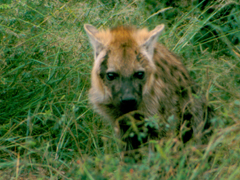 It was already late afternoon, the sky laden with clouds, and the air thick with a hot humid buzz. The lowveld, with its gently rolling hills, seemed overrun by dense green brush and acacia trees in bloom. This is not the dry, earthen colored savanna I remembered from photos in the National Geographic. This year’s unusually rainy wet season transformed the vegetation into a lush, impenetrable wall of thorny green. We also wondered if this meant that most game would be scattered throughout the park and hard to find, because they are not forced to congregate around a few water holes anymore. We probably deserved that, because we paid half price to get in here. But the Gods must be really crazy. As we rounded a turn: a southern white rhino, grazing along the one lane path, jumped backwards at the sudden appearance of our car. Although it was easily three times as big as our Tazz and could have crushed it like a can of soda, it bolted into the bush. I guess rhino don’t like to be surprised. We were lucky, too. Due to their poor eyesight, rhino will just as easy attack something that surprises them. Now that encounter, however brief, was worthy of a high five.
It was already late afternoon, the sky laden with clouds, and the air thick with a hot humid buzz. The lowveld, with its gently rolling hills, seemed overrun by dense green brush and acacia trees in bloom. This is not the dry, earthen colored savanna I remembered from photos in the National Geographic. This year’s unusually rainy wet season transformed the vegetation into a lush, impenetrable wall of thorny green. We also wondered if this meant that most game would be scattered throughout the park and hard to find, because they are not forced to congregate around a few water holes anymore. We probably deserved that, because we paid half price to get in here. But the Gods must be really crazy. As we rounded a turn: a southern white rhino, grazing along the one lane path, jumped backwards at the sudden appearance of our car. Although it was easily three times as big as our Tazz and could have crushed it like a can of soda, it bolted into the bush. I guess rhino don’t like to be surprised. We were lucky, too. Due to their poor eyesight, rhino will just as easy attack something that surprises them. Now that encounter, however brief, was worthy of a high five.
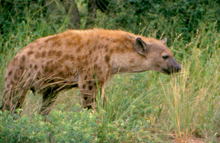 While barreling along the road we had some casual encounters with impala, zebra, wildebeest, and giraffe. While no less impressive, we had run across these herbivores elsewhere outside the park and left them alone for the most part. Until Abdul noticed something small and furry cowering on the edge of the path looking at us with big eyes. He stopped the car and I jumped out.
While barreling along the road we had some casual encounters with impala, zebra, wildebeest, and giraffe. While no less impressive, we had run across these herbivores elsewhere outside the park and left them alone for the most part. Until Abdul noticed something small and furry cowering on the edge of the path looking at us with big eyes. He stopped the car and I jumped out.
“What cute little puppy!” I squealed.
Just as I exclaimed “puppy”, mom of puppy burst out of the dense brush, not looking too amused. She was a fully grown hyena. With my catlike reflexes I grabbed a shot of her with my trusty Nikon and at the same time jumped backward into the car. Just like a seasoned baboon. After this hair raising encounter, we had our fill of animals for the day, but not before coming across a few more rhino. These were quite social and seemed too busy bumping each other’s muzzles gently, to notice Abdul and me gawking at their tender moments.
At Skukuza Camp Abdul pitched his smelly, cramped tent on dusty ground surrounded by a tall barrier made of tall straight branches or small tree trunks. According to the rangers, this kept most dangerous large animals out. We hoped so, too, because our little tent did not seem to be able to resist an elephant running over it. In celebration of our first encounter with a Big Five member, we pulled out the South African boerwors sausage from the back of the car and tossed it on hot coals. After stuffing my face, I noticed a large canvas tent next to ours and it seemed empty and abandoned. Inside was a cot, ready to crash on. I looked around and decided to take a chance on it. Abdul agreed to the idea; this way he could have his tent for himself. It wasn’t until morning that I found out that the park service charges for the use of the tent. Hmmm, better make a beeline for the camp exit, since I am more or less a stowaway here in Kruger and it’s better not to make the rangers aware of my illegal presence inside one of their tents. The mesh doors did do a great job of keeping the mosquitoes out, however, as I ended up with only half the number of nightly bites. Out on the road early in the morning we stopped on a couple of occasions to watch baboons and impala hang out together on the asphalt. They didn’t seem to have the slightest care in the world about the presence of our car, so we steered the Tazz past them slowly and gawked at the baboons just like they gawked at us.
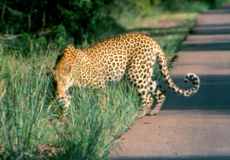 We didn’t really have any particular plans other than driving north through the park toward the Zimbabwe and Mozambique borders. Kruger National Park covers about 19000 square km, stretches 350 km north to south, 60 km east to west and still forms only part of the Greater Limpopo Transfrontier Park. On the Zimbabwean side of the border the Gonarezhou National Park adds another 5000 square km of protected terrain. Additionally, in Mozambique the wildlife area stretches another 10000 square km known as Limpopo National Park. Altogether the Greater Limpopo Transfrontier Park is about as big as Taiwan. Poaching is still an issue in Mozambique, where armed guards patrol the protected area. Sadly, it probably will become an issue in Zimbabwe as well, as that nation’s imploding economy forces people to poach for income and food.
We didn’t really have any particular plans other than driving north through the park toward the Zimbabwe and Mozambique borders. Kruger National Park covers about 19000 square km, stretches 350 km north to south, 60 km east to west and still forms only part of the Greater Limpopo Transfrontier Park. On the Zimbabwean side of the border the Gonarezhou National Park adds another 5000 square km of protected terrain. Additionally, in Mozambique the wildlife area stretches another 10000 square km known as Limpopo National Park. Altogether the Greater Limpopo Transfrontier Park is about as big as Taiwan. Poaching is still an issue in Mozambique, where armed guards patrol the protected area. Sadly, it probably will become an issue in Zimbabwe as well, as that nation’s imploding economy forces people to poach for income and food.
Besides staring back at baboons on the road, the presence of something else on the tarmac grabbed our attention. In the mornings we passed numerous steaming piles of elephant dung, sometimes piled a couple of feet tall. It turned out that these pachyderms use the one and only paved road through the park as a major thoroughfare as well, but only at night. Hence the piles in the morning. We found our source of entertainment quickly: drive as fast as possible and plow into the piles of dung to send it splattering all over. Soon the wheel wells and engine compartment of our Tazz were packed with musty smelling olifant doodoo. But what fun to send excrement flying all over! Our windows were rolled up for this. They were still rolled up for the dung frolic when Abdul spotted something in the rear view mirror crossing the road. We screeched to a halt, backed up. Nothing. We waited. Then after a few minutes a leopard slinked out of the brush. He eyed us intently for a few minutes, circling back and forth, tail curling from side to side. We were enthralled, so much so that I almost forgot to pull the camera out. This deserved a big time high five! What lucky bastards we were to be stalked by a leopard like this. Again, there is no telling what would have happened if we didn’t have our little matchbox of a car nearby. This specimen had an amazing coat, smooth and shiny. Underneath bristled muscles, relaxed now, but ready to jump at any time. Eventually, the leopard lost interest and disappeared into the brush as stealthily as it had appeared. After a bit of driving we turned toward a spur that ended up by a water hole. Usually water holes make for great wildlife viewing, but this being such a wet rainy season, we expected most game to be scattered all over the park. But even here we got lucky. This time a trio of Germans had their gazes fixed on something in the bush. Abdul and I joined, but couldn’t see anything initially. But the unmistakable black lines starting at the eyes and running down on either side of the muzzle gave the cheetah away. I have learned to pull the camera up quickly and it proved to be a good idea again. An instant after the camera’s click, the cheetah’s face disappeared from sight and we never saw it again. This time we high fived the Germans, who seemed amused at our boundless enthusiasm.
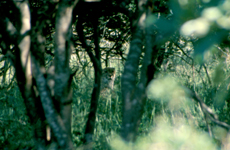 Midday brings searing heat, humidity and a lull in activity. It is best spent hanging out in the shade and moving as little as possible. The insects hummed in a rising crescendo, seemingly pervading everything. Our lunch that Abdul and I prepared on a picnic bench was raped and pillaged by a gang of little black faced monkeys. Even though we were aware of them scampering about in the trees above us, I did not imagine that one of them would have the audacity to jump right onto our table and sweep everything to the ground, where the other little thugs darted out of the bushes and grabbed everything in sight. Scraps of torn plastic bags were all we recovered. Africa won this one. Night time at Kruger is absolutely amazing. Far away from any civilization, the Milky Way arches across the night sky unencumbered by city lights and haze. At the zenith stands the Southern Cross, just four stars, but among the brightest and most iconic of all constellations. On the ground, our night time visitors included jackals and mongoose, animals small enough to slink past the protective wooden barriers of the safari camp. Not too far off, two lions tried to out roar each other through most of the night. It only added to the cacophony of insects chirping and humming in the dark. In the mornings, it is mandatory to pound the shoes against something before putting them on, so that all the scorpions fall out.
Midday brings searing heat, humidity and a lull in activity. It is best spent hanging out in the shade and moving as little as possible. The insects hummed in a rising crescendo, seemingly pervading everything. Our lunch that Abdul and I prepared on a picnic bench was raped and pillaged by a gang of little black faced monkeys. Even though we were aware of them scampering about in the trees above us, I did not imagine that one of them would have the audacity to jump right onto our table and sweep everything to the ground, where the other little thugs darted out of the bushes and grabbed everything in sight. Scraps of torn plastic bags were all we recovered. Africa won this one. Night time at Kruger is absolutely amazing. Far away from any civilization, the Milky Way arches across the night sky unencumbered by city lights and haze. At the zenith stands the Southern Cross, just four stars, but among the brightest and most iconic of all constellations. On the ground, our night time visitors included jackals and mongoose, animals small enough to slink past the protective wooden barriers of the safari camp. Not too far off, two lions tried to out roar each other through most of the night. It only added to the cacophony of insects chirping and humming in the dark. In the mornings, it is mandatory to pound the shoes against something before putting them on, so that all the scorpions fall out.
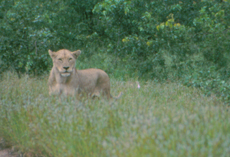 Early morning also meant another mad dash for the bush, as it still is a great time to catch animals out before they disappear for the rest of the day. The elephant dung piles were exceptionally fresh and exploded in green fragments before raining down on our car. Soon the previously white Toyota resembled some outlandishly camouflaged vehicle straight out of Mad Max. After a bend in the road, we came across large mounds of tan colored dung. Did the elephants here consume a different type of food? It didn’t matter; they should still explode spectacularly in front of our bumper. But these were really large piles. Maybe diarrhea. Some squinting, maybe slow down a little, because they look suspicious. Wait, that’s not excrement. Those are lions! A pride of lions, complete with a majestically maned male sprawled out in the middle of the one lane road. Only tails flopped back and forth lazily. They seemed content and well fed. Like going through an obstacle course we maneuvered the little car through their midst. If they were hungry enough or curious enough, any one of them could have ripped a door off with those paws. But now no heads turned and they barely even registered us sneaking past. What an amazing encounter!
Early morning also meant another mad dash for the bush, as it still is a great time to catch animals out before they disappear for the rest of the day. The elephant dung piles were exceptionally fresh and exploded in green fragments before raining down on our car. Soon the previously white Toyota resembled some outlandishly camouflaged vehicle straight out of Mad Max. After a bend in the road, we came across large mounds of tan colored dung. Did the elephants here consume a different type of food? It didn’t matter; they should still explode spectacularly in front of our bumper. But these were really large piles. Maybe diarrhea. Some squinting, maybe slow down a little, because they look suspicious. Wait, that’s not excrement. Those are lions! A pride of lions, complete with a majestically maned male sprawled out in the middle of the one lane road. Only tails flopped back and forth lazily. They seemed content and well fed. Like going through an obstacle course we maneuvered the little car through their midst. If they were hungry enough or curious enough, any one of them could have ripped a door off with those paws. But now no heads turned and they barely even registered us sneaking past. What an amazing encounter!
A little further down the road, the excitement still coursing through our veins, hands throbbing from all the high fives, we came up on yet another lion. This one was a solitary male and he ambled along the road’s edge. This time we got a little cockier and pulled up right next to him. That got his attention. He stared at us with hypnotic amber eyes, pulled his muzzle into a snarl, and unveiled massive canines. I happened to ride on the closest side to this now agitated lion and my heart instantly shot into my throat at the sight of those teeth. Abdul, in the driver’s seat, wisely distanced the little car from the lion, but not before I snapped a photo at the right moment.
Before the day ended, a few more lions crossed our path, plenty of zebra, wildebeest, giraffe, impala, matriarchal herds of elephants, hippos, and then finally, Cape buffalo. Not just one, but a whole herd. The whole herd also stared our way as we slowed down to peer at them through the dense undergrowth. Cape buffalo are notoriously unpredictable and these specimens proved just that by suddenly charging off in different directions with no warning. I do remember seeing a tree shake violently for a moment, probably due to a collision with a buffalo. The scattering of the buffalo also set us in a panic and I quickly scampered down from the roof of the Toyota and Abdul gunned it, lest we get caught in a stampede.
Away from that bovine fury, we high fived yet again for encountering all five of Africa’s big game. Africa won and we won. Toward evening, it was time to sniff up another protected bush camp to spend the night at, but not before running into a mountain of an elephant. This solitary bull wandered right down the middle of the road toward us and left no room to maneuver past. For the next twenty minutes, we had the car in reverse just to keep a respectable distance. Eventually he decided to wander off the road’s edge and uproot a small tree just for fun. That was our chance! We zipped past him like little mice might zip around a house to avoid the cat.
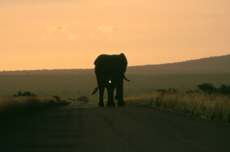 Finally, our amazing time at Kruger was not to end until we buried the car in water up to the doors just before the Mozambique border. That was not nearly as scary, as the prospect of the car getting searched by armed rangers upon leaving the game reserve. Just like the very beginning, I hid behind the front seats, because we figured they would ask to see an entry permit at the exit. To Abdul’s horror, the only car ahead of us was in the process of being strip searched. “To discourage poaching”, said one of the rangers. There is no way I was not going to get discovered! These guys are trained to sniff out hidden items. And I was a hidden item, not poached, but definitely hidden. And no permit. All Abdul managed to say was “oh, mother$&#@*, we’re f#*&$”. A ranger armed with a rifle came up and ordered him to open the trunk. I didn’t make a peep behind the seat, not yet. But I wasn’t far from soiling my pants either. After he rummaged through the back, he peered into the backseat, but didn’t bother to take a closer look underneath the camping gear, where I hid myself. That was our final victory: all other vehicles gutted and reassembled, except ours. The Gods were indeed crazy to let Abdul and I get away with this. We left the park boundaries behind; naively elated that we didn;t get caught swindling our way through. Somehow we managed to experience the safari of a lifetime on our own terms and on a shoestring budget with a tiny little car and nothing more than a tent. Whenever I am held up by a traffic jam in the modern world, I just close my eyes and imagine the elephants with their ivory tusks holding us up as they take their jolly old time crossing the road. It was absolutely worth the trip.
Finally, our amazing time at Kruger was not to end until we buried the car in water up to the doors just before the Mozambique border. That was not nearly as scary, as the prospect of the car getting searched by armed rangers upon leaving the game reserve. Just like the very beginning, I hid behind the front seats, because we figured they would ask to see an entry permit at the exit. To Abdul’s horror, the only car ahead of us was in the process of being strip searched. “To discourage poaching”, said one of the rangers. There is no way I was not going to get discovered! These guys are trained to sniff out hidden items. And I was a hidden item, not poached, but definitely hidden. And no permit. All Abdul managed to say was “oh, mother$&#@*, we’re f#*&$”. A ranger armed with a rifle came up and ordered him to open the trunk. I didn’t make a peep behind the seat, not yet. But I wasn’t far from soiling my pants either. After he rummaged through the back, he peered into the backseat, but didn’t bother to take a closer look underneath the camping gear, where I hid myself. That was our final victory: all other vehicles gutted and reassembled, except ours. The Gods were indeed crazy to let Abdul and I get away with this. We left the park boundaries behind; naively elated that we didn;t get caught swindling our way through. Somehow we managed to experience the safari of a lifetime on our own terms and on a shoestring budget with a tiny little car and nothing more than a tent. Whenever I am held up by a traffic jam in the modern world, I just close my eyes and imagine the elephants with their ivory tusks holding us up as they take their jolly old time crossing the road. It was absolutely worth the trip.

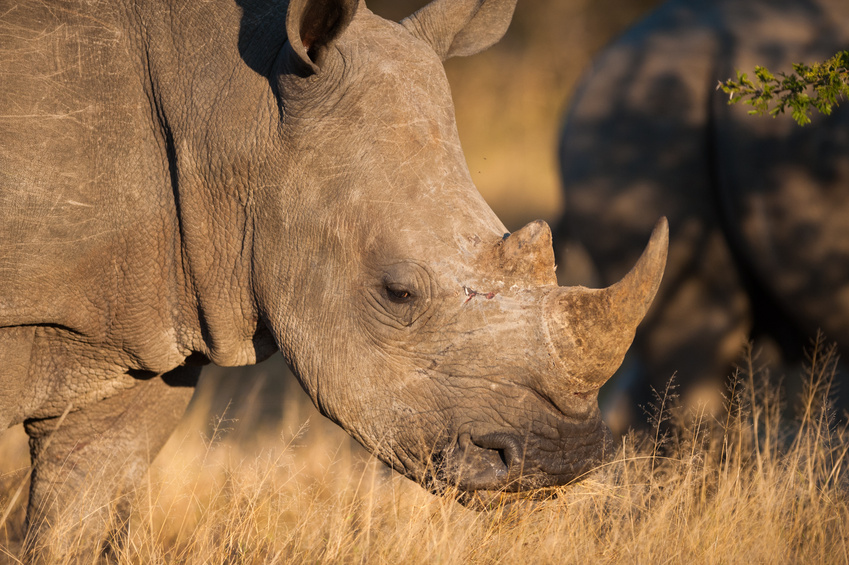
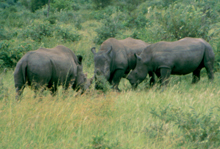
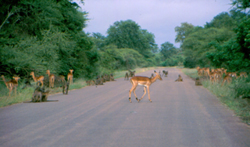
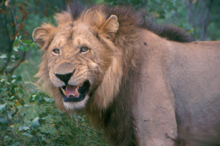
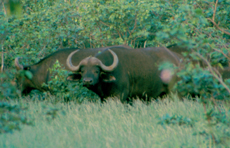
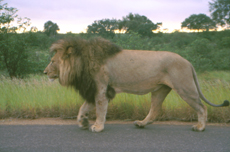
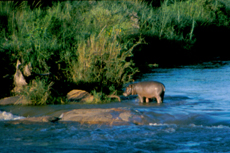
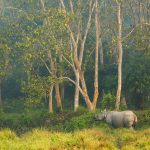
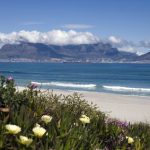

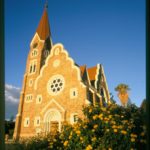
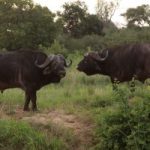

Bwahahaha. This article never gets old!
It must be amazing to travel South Africa for Safari. I enjoyed browsing your photos but it might have been better to have higher resolution pictures. I mean those creatures are just impressive. Enjoyed a lot anyway! Thank you for the good share.
This trip was in 2004 and it was a pre-digital camera. We thought the same when we finished the trip and it’s what compelled us to make the switch to digital.